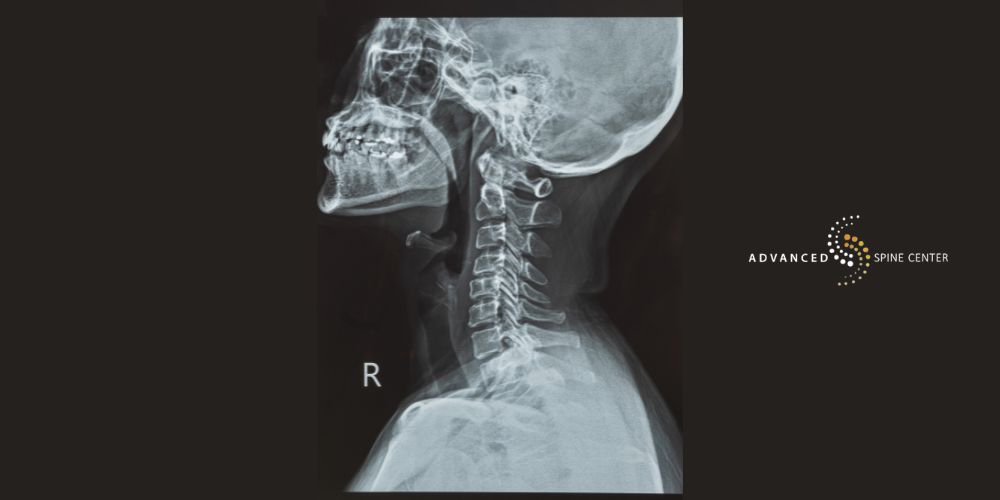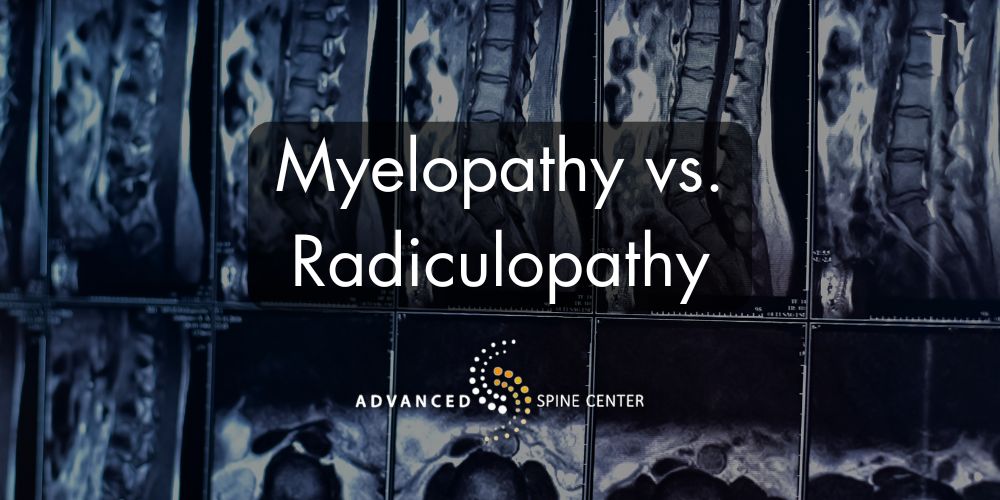Table of Contents
If you’ve been struggling with neck pain, arm numbness, or weakness in your hands or legs, you might be wondering what’s really causing your symptoms. Understanding myelopathy vs. radiculopathy is an important step toward getting the right diagnosis and finding relief.
Myelopathy and radiculopathy may seem similar, but they affect different parts of the spine and nerves, and can lead to very different outcomes if left untreated. Whether you’re dealing with cervical radiculopathy from a pinched nerve or signs of cervical myelopathy from spinal cord compression, knowing the difference can help you explore the right treatment options.
If you’ve noticed muscle weakness, difficulty holding small objects, or changes in bladder function, don’t wait to get help. Contact Advanced Spine Center in Plano, TX, at (972) 499-5457 or visit our online contact page to schedule an appointment today.
Myelopathy Definition
Myelopathy is a condition that occurs when the spinal cord becomes compressed and is often caused by issues like spinal stenosis, disc herniation, or degenerative changes. This compression can interfere with nerve signals between the brain and the rest of the body, leading to symptoms like muscle weakness, difficulty walking, problems with coordination, or changes in bladder function.

How Myelopathy Affects Different Areas of the Spinal Cord
Myelopathy can affect different parts of the spinal cord depending on where the compression happens. The spinal cord runs from the brain down through the spinal canal and sends signals to various parts of the body.
When compression occurs in certain regions, such as the cervical spine, thoracic spine, or lumbar spine, it can lead to different symptoms. Understanding where the spinal cord is affected helps your doctor choose the right treatment options and determine how serious the condition may be.
Cervical Myelopathy
Cervical myelopathy happens when the spinal cord becomes compressed in the neck, or cervical spine. This is the most common type of myelopathy. It often results from degenerative changes like spinal stenosis, disc herniation, or rheumatoid arthritis.
Symptoms of cervical myelopathy may include neck pain, weakness in the arms or hands, numbness, difficulty with coordination, and problems gripping small objects. Because the cervical spinal cord controls signals to the entire spinal cord below that level, symptoms can also extend to the lower extremities.
Lumbar Myelopathy
True lumbar myelopathy is rare because the spinal cord usually ends around the level of the first or second lumbar vertebra. However, severe compression in this area can affect the nerves in the lumbar spine, leading to symptoms that mimic myelopathy. These symptoms may include lower extremity weakness, bladder function issues, and difficulty walking.
Thoracic Myelopathy
Thoracic myelopathy occurs in the middle part of the spine and is less common than cervical myelopathy. This type of myelopathy can result from disc protrusion, spinal stenosis, or degenerative spondylolisthesis in the thoracic region.
Since the spinal canal is narrower here, even mild compression of the spinal cord can lead to symptoms such as numbness, motor weakness, balance problems, and pain in the trunk or lower extremities. Left untreated, thoracic myelopathy can lead to long-term neurological deficits.
Symptoms of Myelopathy
Symptoms of myelopathy can develop slowly and may vary depending on the location and severity of spinal cord compression. Common signs include muscle weakness, numbness in the arms or legs, trouble with balance, and weakness in the extremities that makes it difficult to walk or hold small objects. Some people may also experience stiffness in the neck, loss of coordination, or problems with bladder function.
Because these symptoms can resemble other spine and nerve conditions, like radiculopathy, it’s important to get a proper differential diagnosis through diagnostic imaging, like a spine MRI or nerve conduction studies.
Common Causes of Myelopathy
Myelopathy is most often caused by conditions that lead to spinal cord compression, including spinal stenosis, disc herniation, degenerative spondylolisthesis, and degenerative changes such as arthritis. Over time, wear and tear on the spine can narrow the spinal canal, causing it to press against the cervical spinal cord. Other causes include rheumatoid arthritis, spinal injuries, tumors, and neurological conditions like multiple sclerosis. In many cases, a spine MRI or other diagnostic imaging is needed to pinpoint the exact source of the compression.
Radiculopathy Definition
Radiculopathy occurs when a nerve root becomes compressed or irritated as it exits the spinal canal. This type of nerve root compression can cause symptoms such as radicular pain, numbness, tingling, or muscle weakness along the path of the affected nerve.
Common causes include a herniated disc, disc protrusion, spinal stenosis, or degenerative changes that narrow the neural foramina. While radiculopathy does not affect the spinal cord itself, it can still make everyday movements painful and limit function.

How Radiculopathy Affects Different Areas of the Spinal Cord
Radiculopathy can happen in different regions of the spine depending on which nerve roots are compressed. While the spinal cord remains unaffected, the spinal nerves that branch off from it can become irritated or pinched, leading to symptoms that travel along the affected nerve pathway. Understanding whether you have cervical, thoracic, or lumbar radiculopathy can help your doctor recommend the right treatment options to relieve symptoms and prevent long-term damage.
Cervical Radiculopathy
Cervical radiculopathy develops when a nerve root in the cervical spine becomes compressed. This typically happens due to disc herniation, degenerative changes, or spinal stenosis. Common symptoms of cervical radiculopathy include neck pain, radicular pain that radiates into the shoulder, arm, or hand, and muscle weakness or numbness in those areas. In some cases, patients may have trouble gripping small objects or experience a burning or tingling sensation down one arm.
Lumbar Radiculopathy
Lumbar radiculopathy occurs when a nerve root in the lumbar spine becomes pinched or inflamed, often due to a herniated disc, disc protrusion, or degenerative spondylolisthesis. This type of radiculopathy usually causes pain, numbness, or weakness in the lower extremities, including the buttocks, thighs, legs, or feet.
Thoracic Radiculopathy
Thoracic radiculopathy occurs when a nerve root in the mid-back area becomes compressed or irritated, leading to symptoms such as burning, stabbing, or radicular pain that wraps around the chest or upper abdomen. This condition is less common than cervical or lumbar radiculopathy, but it can still cause significant discomfort and interfere with daily activities.
Causes of thoracic radiculopathy may include disc herniation, degenerative changes, or spinal stenosis in the thoracic spine. Because the symptoms can mimic other health issues, diagnostic imaging, like a spine MRI, is often used to confirm the diagnosis and guide treatment options.
Radiculopathy Symptoms
Radiculopathy symptoms depend on which nerve roots are affected, but they can include pain, numbness, tingling, and muscle weakness along the path of the affected nerve. Symptoms may worsen with certain movements or positions and can make it difficult to walk, lift objects, or perform daily tasks. Because radiculopathy and myelopathy can have similar symptoms, a proper diagnosis is important to determine the right treatment options.
Common Causes of Radiculopathy
Radiculopathy usually happens when something puts pressure on the nerve roots as they exit the spinal canal. A herniated disc or disc protrusion is one of the most common causes, especially in the cervical spine and lumbar spine. Other causes of radiculopathy include degenerative changes like spinal stenosis, degenerative spondylolisthesis, or thickening of the ligaments near the spine. Repetitive movements, trauma, or arthritis can also lead to nerve root compression.
Is Radiculopathy the Same as a Pinched Nerve?
A pinched nerve refers to the physical pressure or irritation of a nerve root, while radiculopathy describes the symptoms that result from that pressure, such as pain, numbness, tingling, or muscle weakness. In other words, a pinched nerve is the cause, and radiculopathy symptoms are the effect.
Key Differences Between Myelopathy and Radiculopathy
While both conditions involve nerve compression and may share similar symptoms, they affect different parts of the nervous system and can lead to very different outcomes. Knowing whether the issue involves the spinal cord or the nerve roots is important when determining the right treatment options.
Location of Compression
The main difference between myelopathy and radiculopathy is where the compression occurs. Myelopathy involves compression of the spinal cord, most often in the cervical spine, but it can also affect the thoracic or, in rare cases, the lumbar spine.
Radiculopathy, on the other hand, involves compression of the nerve roots that branch off the spinal cord, usually in the neural foramina. This distinction affects how symptoms appear and how your doctor will approach treatment.
Nature of Symptoms
With myelopathy, symptoms tend to be more widespread and may include muscle weakness, extremity weakness, coordination problems, and even bladder function issues due to damage along the entire spinal cord pathway.
In contrast, radiculopathy causes more localized issues such as radicular pain, numbness, or tingling along a specific nerve path, usually limited to one arm or leg. While both may involve pain and weakness, myelopathy often causes more serious neurological deficits.
Severity and Potential Outcomes
Myelopathy is generally more serious than radiculopathy because it directly affects the spinal cord, which controls motor and sensory signals throughout the body. If left untreated, spinal cord compression can lead to permanent motor weakness or loss of function in the lower extremities.
Radiculopathy can cause discomfort and reduce quality of life, but it usually responds well to conservative treatments like physical therapy and doesn’t typically result in permanent damage unless the nerve compression becomes severe.

Treatment Options for Radiculopathy and Myelopathy
Whether it’s nerve root compression from a herniated disc or spinal cord compression in the cervical spine, the goal of radiculopathy and myelopathy treatments in Plano, TX, is to relieve pressure, reduce pain, and restore function. Many patients begin with non-surgical care, but when symptoms worsen or don’t improve, surgery may be necessary to prevent permanent damage.
Non-Surgical Treatments for Myelopathy and Radiculopathy
For mild to moderate symptoms, doctors often begin with conservative care to manage radiculopathy and myelopathy. Physical therapy can help strengthen muscles, improve posture, and reduce strain on the spinal nerves or cervical spinal cord. Anti-inflammatory medications, rest, and avoiding repetitive movements may also help relieve pain and improve function. Diagnostic imaging, such as a spine MRI and nerve conduction studies, can guide treatment plans and track progress over time.
Surgical Treatment Options for Myelopathy
If symptoms progress to include motor weakness, extremity weakness, or bladder function issues, surgical treatment may be necessary to relieve spinal cord compression and protect the entire spinal cord from further damage. Common procedures include:
- Decompression Surgery: Removes the structure causing compression, such as a disc herniation, bone spur, or thickened ligament, to take pressure off the spinal cord.
- Cervical Fusion Surgery: Stabilizes the spine by joining two or more vertebral bodies, often performed after decompression to prevent movement in the affected area.
- Laminectomy: Involves removing the lamina (back part of the vertebra) to widen the spinal canal and reduce cord compression, especially in cases of cervical myelopathy.
Surgical Treatment Options for Radiculopathy
If radiculopathy symptoms don’t respond to non-surgical care or become more severe, surgery may be needed to relieve pressure on the affected nerve roots. Surgical options include:
- Microdiscectomy: A minimally invasive procedure that removes a portion of a herniated disc pressing on a nerve root, often used in lumbar radiculopathy.
- Foraminotomy: Enlarges the neural foramina (openings where spinal nerves exit) to relieve nerve compression caused by bone spurs or disc issues.
- Cervical Disc Replacement Surgery: Replaces a damaged intervertebral disc with an artificial disc, helping preserve motion and relieve pressure in the cervical spine.
Contact Advanced Spine Center for Myelopathy and Radiculopathy Treatments in Plano, TX
If you’re experiencing symptoms like neck pain, muscle weakness, numbness, or radicular pain in your arms or legs, myelopathy or radiculopathy may be the cause. At Advanced Spine Center in Plano, TX, our team is here to evaluate your condition using advanced diagnostic imaging, guide you through personalized care, and help relieve your symptoms. Call us today at (972) 499-5457 or visit our online contact page to schedule your appointment.










